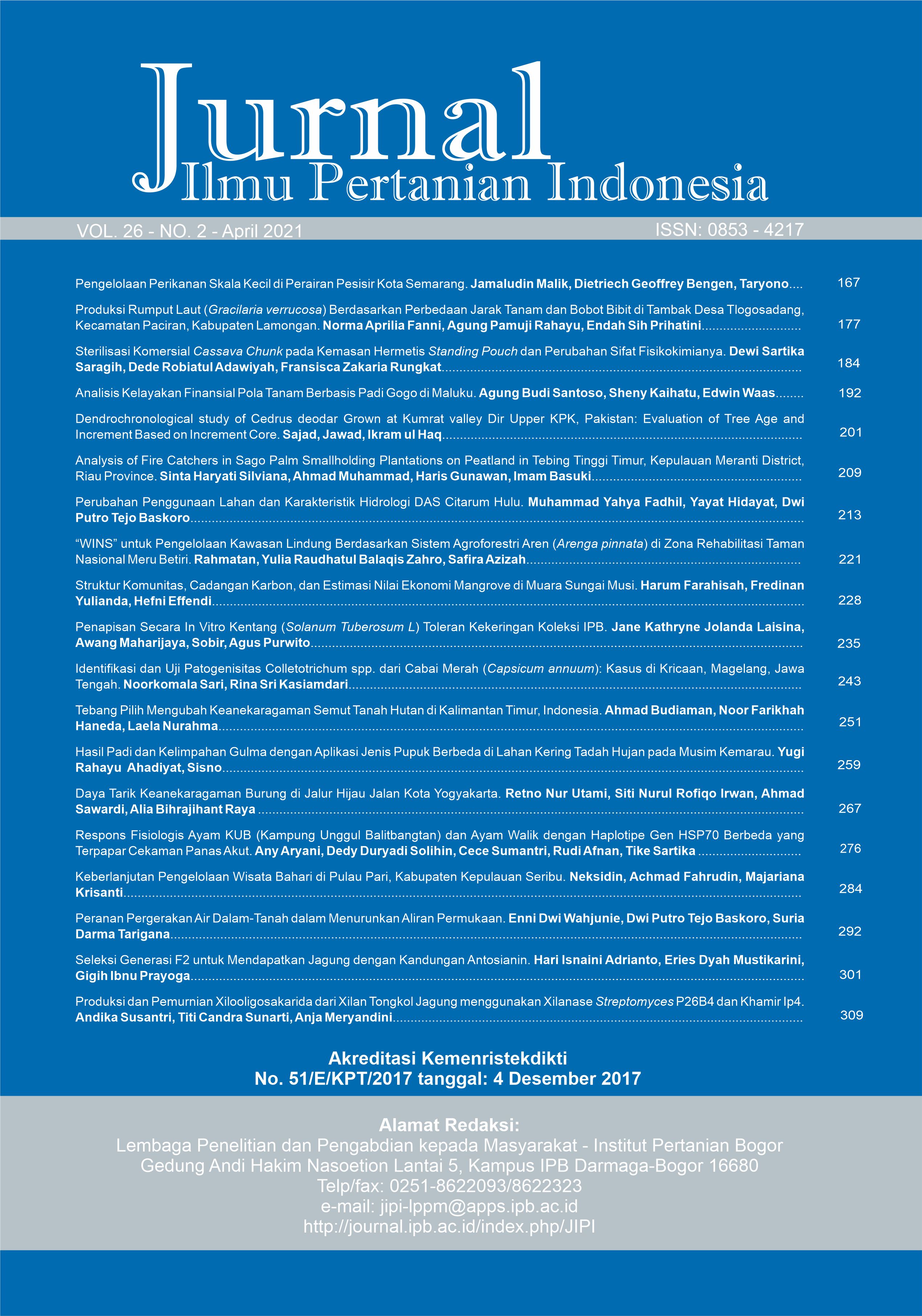The In Vitro Screening of Drought Tolerant Potatoes (Solanum tuberosum L) of the Center for Tropical Horticulture Studies - IPB collections
Abstract
In supporting the replacement of potato varieties with the varieties that are adaptive to drought, effective and fast methods are needed. One of which is through in vitro screening of drought-tolerant genotypes. The aims of this research were to determine the appropriate concentration of sorbitol as a critical limit in the in vitro screening process of drought-tolerant genotypes, as well as to determine vegetative characteristics that could be used as indicators of in vitro selection and also to obtain in vitro drought-tolerant genotypes. To achieve these objectives, we used single-nodal explants of seven genotypes cultured for six weeks on MS media added with four levels of sorbitol concentration. Of the four treatments, sorbitol level that could distinguish susceptible and tolerant plants was 0.2 M sorbitol and at this concentration, the characteristics that showed significant interactions were plant height and root length, so that both characteristics could be used as selection indicators for the analysis of tolerance tests for the seven genotypes. The results of tolerance test using the analysis of relative decline and stress-susceptibility index (SSI) showed that PKHT4 and PKHT6 were the genotypes that were tolerant in vitro.
Keywords: drought tolerant, in vitro, Solanum tuberosum, sorbitol
Downloads
References
Acquaah G. 2007. Principles of plant genetics and breeding. Blackwell Publishing Ltd. USA.
Albiski F, Najla S, Sanoubar R, Alkabani N, Murshed R. 2012. In vitro screening of potato lines for drought tolerance. Physiology and Molecular Biology of Plants. 18(4): 315321. https://doi.org/ 10.1007/s12298-012-0127-5
Aliche EB, Oortwijn M, Theeuwen TPJM, Bachem CWB, Visser RGF, van der Linden CG. 2018. Drought response in field grown potatoes and the interactions between canopy growth and yield. Agricultural Water Management. 206: 2030. https://doi.org/10.1016/j.agwat.2018.04.013
Aliche EB, Prusova-Bourke A, Ruiz-Sanchez M, Oortwijn M, Gerkema E, Van AH, van der Linden CG. 2020. Morphological and physiological responses of the potato stem transport tissues to dehydration stress. Planta. 251(2): 115. https:// doi.org/10.1007/s00425-019-03336-7
Anithakumari AM, Dolstra O, Vosman B, Visser RGF, van der Linden CG. 2011. In vitro screening and QTL analysis for drought tolerance in diploid potato. Euphytica. 181(3): 357369. https://doi.org/ 10.1007/s10681-011-0446-6
Atlin GN, Cairns JE, Das B. 2017. Rapid breeding and varietal replacement are critical to adaptation of cropping systems in the developing world to climate change. Global Food Security. 12: 3137. https://doi.org/10.1016/j.gfs.2017.01.008
Austin JH. 2011. References and Notes. Meditating Selflessly. 333: 616621. https://doi.org/10.7551/ mitpress/8876.003.0036
Boguszewska-Mańkowska D, Zarzyńska K, Nosalewicz A. 2020. Drought Differentially Affects Root System Size and Architecture of Potato Cultivars with Differing Drought Tolerance. American Journal of Potato Research. 97(1): 5462. https://doi.org/10.1007/s12230-019-09755-2
Bündig C, Vu TH, Meise P, Seddig S, Schum A, Winkelmann T. 2016. Variability in Osmotic Stress Tolerance of Starch Potato Genotypes (Solanum tuberosum L.) as Revealed by an In Vitro Screening: Role of Proline, Osmotic Adjustment and Drought Response in Pot Trials. Journal of Agronomy and Crop Science. 203(3): 206218. https://doi.org/10.1111/jac.12186
Dahal K, Li XQ, Tai H, Creelman A, Bizimungu B. 2019. Improving potato stress tolerance and tuber yield under a climate change scenario – a current overview. Frontiers in Plant Science. 10: 116. https://doi.org/10.3389/fpls.2019.00563
Fischer RA, Maurer R. 1978. Drought Resistance in Spring Wheat Cultivars . I Grain Yield Responses. Australian Journal of Agricultural Research. 29: 897912.
Gelmesa D, Dechassa N, Mohammed W, Gebre E, Monneveux P, Bündig C, Winkelmenn T. 2017. In vitro screening of potato genotypes for osmotic stress tolerance. Open Agriculture. 2(1): 308316. https://doi.org/10.1515/opag-2017-0035
Gopal J, Iwama K. 2007. In vitro screening of potato against water-stress mediated through sorbitol and polyethylene glycol. Plant Cell Reports. 26(5): 693700. https://doi.org/10.1007/s00299-006-0275-6
Khan MA, Gemenet DC, Villordon A. 2016. Root system architecture and abiotic stress tolerance: Current knowledge in root and tuber crops. Frontiers in Plant Science. 7: 113. https://doi.org/10.3389/fpls.2016.01584
Kumar S, Dwivedi SK, Singh SS, Jha SK, Elanchezhian R, Bhatt BP. 2014. Identification of drought tolerant rice genotypes by analysing drought tolerance indices and morpho-physiological traits. Sabrao Journal of Breeding and Genetics. 46(2): 217230.
Levy D, Coleman WK, Veilleux RE. 2013. Adaptation of Potato to Water Shortage: Irrigation Management and Enhancement of Tolerance to Drought and Salinity. American Journal of Potato Research. 90(2): 186206. https://doi.org/10.1007/s12230-012-9291-y
Monneveux P, Ramírez DA, Khan MA, Raymundo R, Loayza H, Quiroz R. 2014. Drought and Heat Tolerance Evaluation in Potato (Solanum tuberosum L.). Potato Research. 57(3–4): 225247. https://doi.org/10.1007/s11540-014-9263-3
Nasiruddin MN, Islam ARA. 2018. in Vitro Slow-Growth Conservation for Two Genotypes of Solanum Tuberosum L. Bangladesh Journal of Botany. 47(3): 369380.
Neni N, Maharijaya A, Syukur M. 2018. Keragaan Produksi Kentang G2 Genotipe IPB Asal Stek dan Umbi di Garut Jawa Barat Potato. Bulletin Agrohorti. 6(3): 397404.
Obidiegwu JE, Bryan GJ, Jones HG, Prashar A. 2015. Coping with drought: Stress and adaptive responses in potato and perspectives for improvement. Frontiers in Plant Science. 6: 123. https://doi.org/10.3389/fpls.2015.00542
Tardieu F. 2012. Any trait or trait-related allele can confer drought tolerance: Just design the right drought scenario. Journal of Experimental Botany. 63(1): 2531. https://doi.org/10.1093/jxb/err269
Tuberosa R. 2012. Phenotyping for drought tolerance of crops in the genomics era. Frontiers in Physiology. 3: 126. https://doi.org/ 10.3389/fphys.2012.00347
Zulkarnain DH, Maharijaya A, Syukur M. 2017. Uji Daya Hasil Klon Harapan Kentang (Solanum tuberosum L.) IPB di Kabupaten Garut Jawa Barat. Comm. Horticulturae Journal. 1(1): 42.
This journal is published under the terms of the Creative Commons Attribution-NonCommercial 4.0 International License. Authors who publish with this journal agree to the following terms: Authors retain copyright and grant the journal right of first publication with the work simultaneously licensed under a Creative Commons Attribution-NonCommercial 4.0 International License. Attribution — You must give appropriate credit, provide a link to the license, and indicate if changes were made. You may do so in any reasonable manner, but not in any way that suggests the licensor endorses you or your use. NonCommercial — You may not use the material for commercial purposes.
10.1007/978-3-031-43729-8_15
10.1007/s12892-025-00275-6
10.3390/horticulturae8070591
10.1007/s11056-022-09958-2























